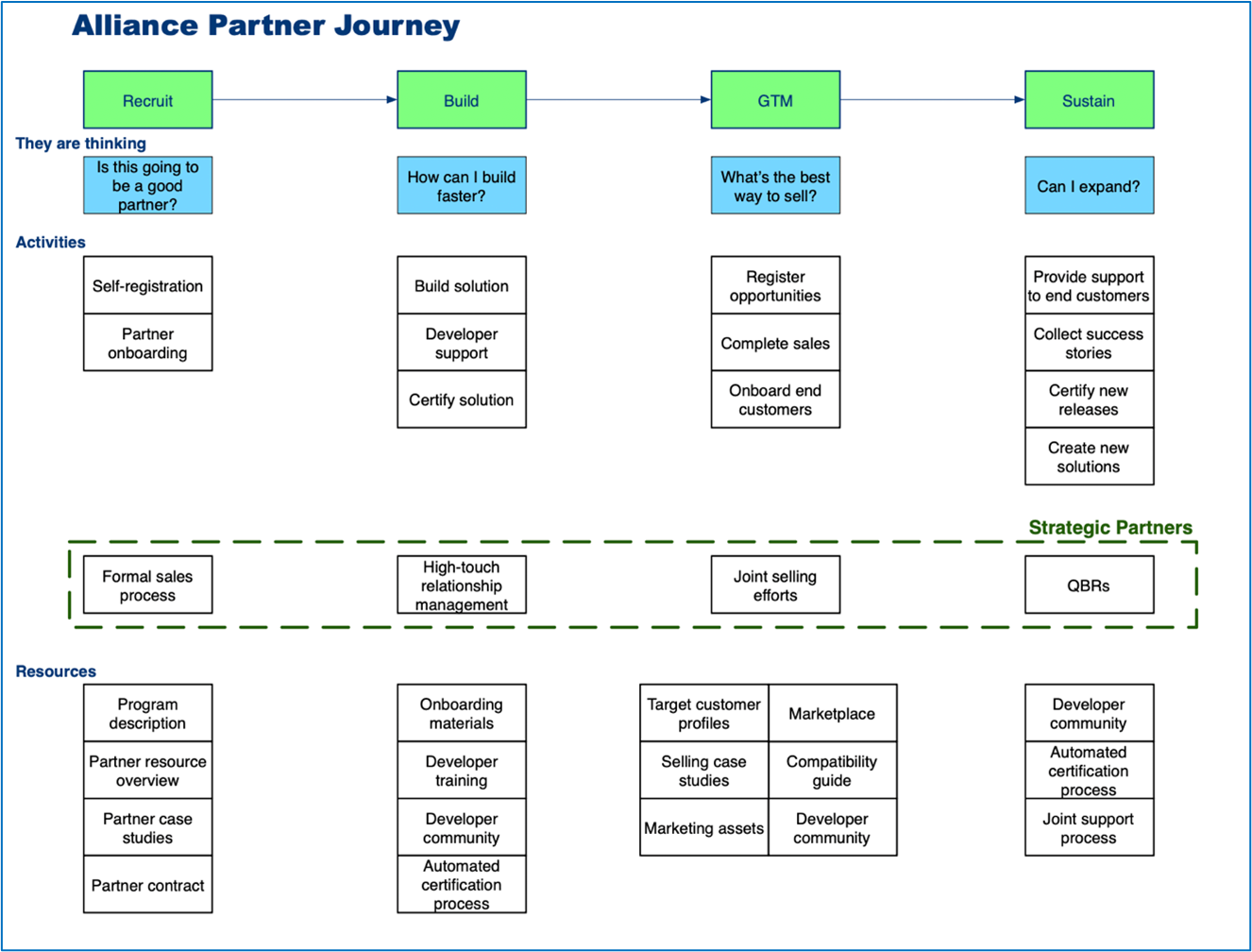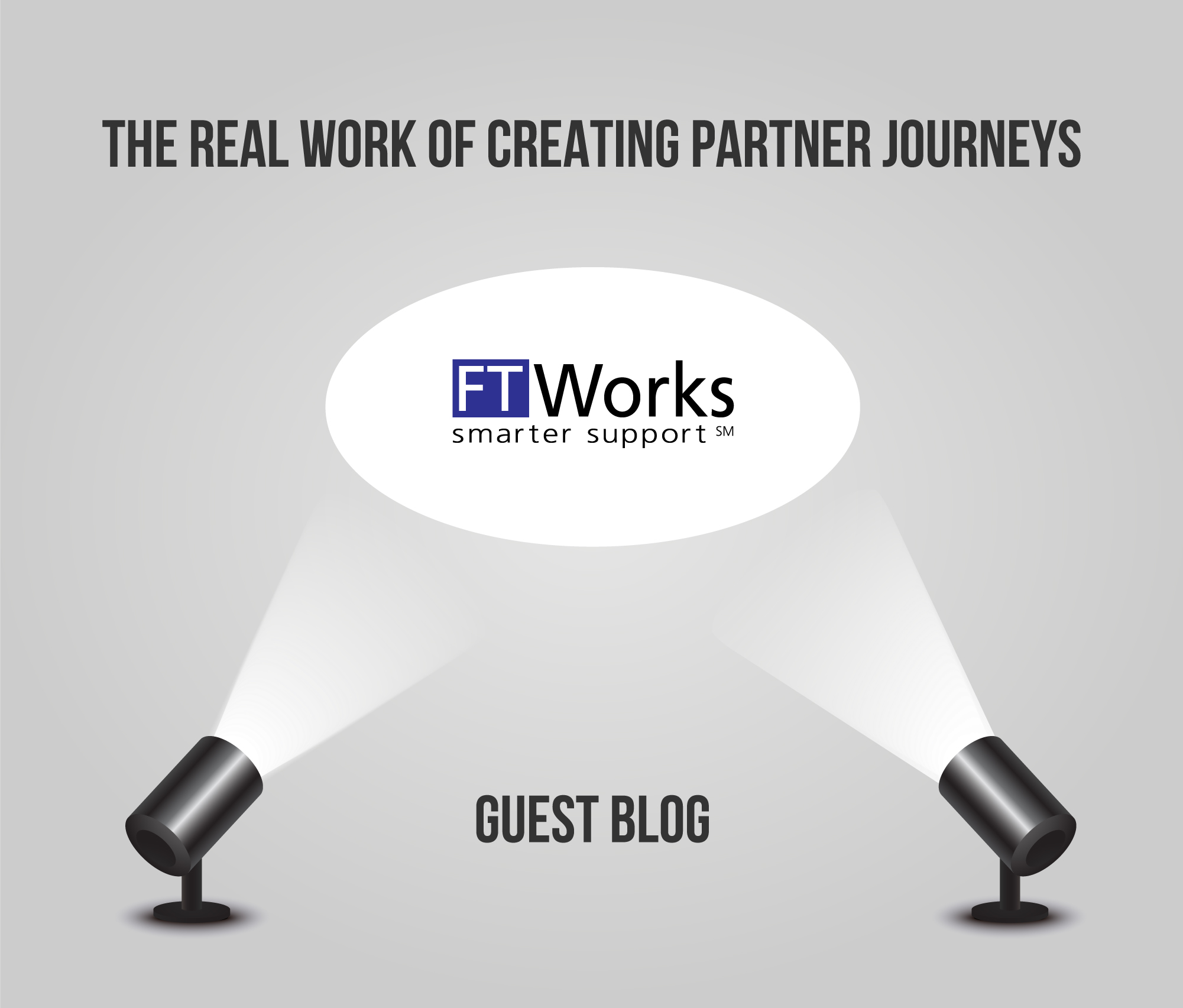In a post back in November, we talked about how creating partner journeys can amplify the impact of the Alliance Partner team by allowing multiple teams to collaborate towards the success of partners, and we also gave an overview of the mapping process.
Here, we delve deeper into the process of creating journeys with more details on how to organize the mapping exercise. We also provide suggestions to create a better, more actionable final product
What is a partner journey?
A partner journey is a visual description of steps and experiences partners have from making the decision of becoming a partner all the way to maintaining a long-term relationship. Here’s an example:
Once you assemble the right team (representing all aspects of the business that interact with partners), we recommend using a four-step process, described below. For simplicity’s sake, it’s described as linear but do expect to go back to earlier steps, perhaps multiple times. Looping back is absolutely normal and healthy, especially if it’s your first journey mapping exercise.

Step 1: Education & Goal Setting
Goal
The first step is to get the team members aligned on what journeys are and what the project will look like. By the end of this step, we want the participants to have a clear idea of
- what the deliverables should look like (personas and journeys)
- why you are undertaking the project (how the journeys will be used)
- how the project will unfold (milestones and timeline)
- what contributions they are expected to make (ideation, documentation, reviews)
Input
You may be starting the mapping project entirely from scratch, but it’s likely that some efforts have been made to identify personas and draft journeys or partial journeys. Gather the existing artifacts, regardless of quality, so you can acknowledge your predecessors, evaluate the maturity of the organization and the journeys, and reuse promising materials.
Process
This step is a mix of education and group goal setting.
- Education for the participants who have never worked on journeys or may have a very different idea from the type of journeys you would like to create. Share examples of personas and journeys. I like to draft at least one persona and journey relevant to the particular situation (using your background research) so participants immediately grasp how it could be used.
- Group goal setting. Once everyone has some knowledge of journeys, discuss how the journeys will be used. Typically, we use journeys to identify critical touchpoints and improve them, as well as the handoffs between touchpoints.
Caveats
Don’t skip this phase. Many participants likely think that journeys are pretty pictures that waste everyone’s time. Take the time to get the team to embrace the idea that journeys are a useful tool to improve the partners’ experience.
Step 2: Defining Personas
Goal
Before creating journeys, we must define personas, that is, the types of individuals who will undertake the journeys. The goal for this step is to define a handful of archetypes that capture the various types of individuals we work with, with critical attributes for each. Knowing the actors’ needs will inform the touchpoints in the journey to be built.
Input
You may be able to recycle existing personas. In my experience, existing personas are often (1) defined only for prospects, ignoring important post-sales personas, and (2) too numerous and detailed to be practical for journey mapping—but they are a start.
Process
For each persona, give them a name, a face (it helps make them real), a job title, a professional background. Record their responsibilities and goals. Provide draft personas, which the team members will love to “improve” aka destroy. For instance, start with Brad the development manager, Eva the engineering manager, and Sunil the support manager.
It can take many hours to come up with the list and attributes of personas. Scheduling a series of shorter meetings (under 2 hours) rather than one large workshop allows participants to reflect and come to more thoughtful agreements.
Caveats
Don’t let the list of personas grow too long (say more than 8), since personas that cannot be recalled are useless. If the list must be long, focus on a few essential players to start.
Team members often debate whether to merge various personas. Allow the discussion to proceed but don’t waste time arguing small points. Move to the next step once you have a reasonable set of personas; you can always go back and revisit the personas.
Step 3: Defining Journey Phases
Goal
Journeys are organized in phases, which are the same across personas (although some personas may be completely inactive during some phases). Defining a set of phases before plunging into the details of the journey helps structure and streamline the process. The goal for this step is to define 4-8 phases with entrance and exit criteria. Each phase must make sense to the partners, not just the internal organizations.
Input
You may be able to retrieve useful phase information from existing journeys.
Process
Propose phases that make sense for your organization and allow team members to chime in. Often, phases are defined by natural transitions between one set of activities to another, or between one internal team to another. For instance,
- Recruiting (everything that happens up to the point of a partner signing the agreement)
- Solution building (creating and certifying the solution, assuming that’s your model, up to solution certification)
- GTM (orchestrating the first few sales)
- Sustaining (nurturing the relationship to success and expansion)
There is no magic set of phases, and once again, it’s common to find that phases are refined during the journey-mapping process, so move on as soon as you have a solid candidate set.
Caveats
If a phase cannot be defined with a beginning and an end, it’s not a phase.
Include the entire lifecycle in the phases. If you cannot do that, you’re likely missing key participants in your project team.
It’s very useful to use short names for the phases, but don’t waste too much time arguing about the exact names. Pick a reasonable set and move on.
Step 4: Identifying Critical Activities
Goal
The output of this step is a set of journeys, one for each of the personas you defined. The project may also include identifying critical touchpoints and defining initiatives to add, improve, or remove touchpoints.
Input
Use the personas and phase definitions you created in steps 2 and 3 and reuse existing journeys if they are useful.
Process
Start with a persona that’s “important” and has a lot going in many of the phases. It will take a long time to create a journey for that persona, but once that’s done you will be able to adapt their rich, complex journey to other personas. (Do not start with peripheral personas’ journeys: they will give the team a false sense of success—or boredom.)
As you did for personas, present drafts of journeys rather than asking the team to create from scratch. It will be much faster.
Proceed systematically, journey by journey and phase by phase. Do not move to the next phase or the next persona until you have reasonable agreement from the team.
Allow reworking personas or phases as needed. I find that creating the first journey solidifies the phases once and for all, while refining personas may occur throughout the entire mapping process. A common occurrence is to find that two personas have almost-identical journeys and can be merged. Be on the lookout for those situations.
As you build the journeys, ask the team members to identify missing or broken touchpoints. Push them to define journeys that capture an ideal customer experience, not necessarily what’s happening now.
Caveats
Expect to iterate on the journeys a lot, especially for the first one you tackle.
Bon voyage!
Journey mapping is an iterative process: you likely won’t create a perfect set of journeys on your first try, and it’s probably not a realistic or even desirable goal. Instead, expect to come back to the journeys on a regular basis to improve them. Subsequent mapping exercises will be much smoother, faster, and successful than the first one.
Francoise Tourniaire is the author of The Art of Support and the founder of FT Works, a boutique consulting firm that helps technology companies improve their customer success and support organizations through targeted consulting and training solutions, including creating customer and partner journeys. You can reach her here.

